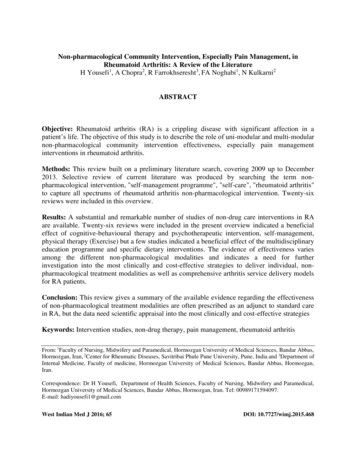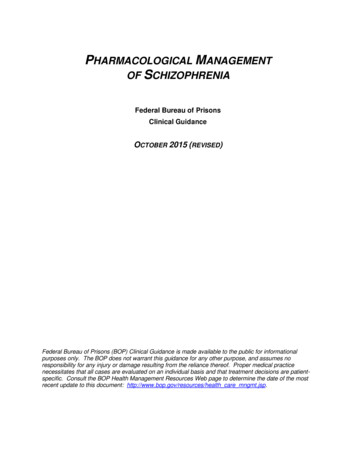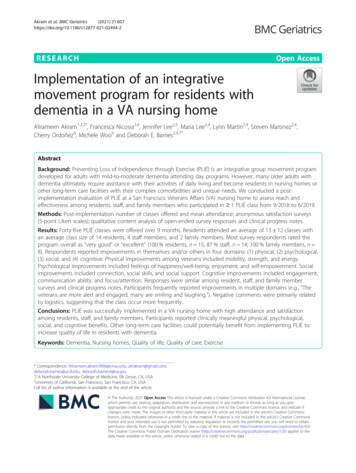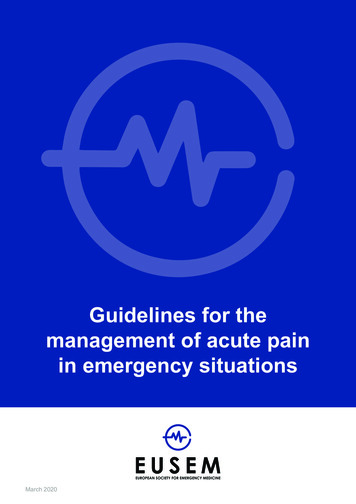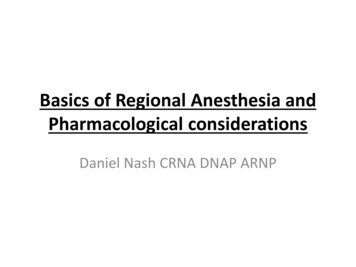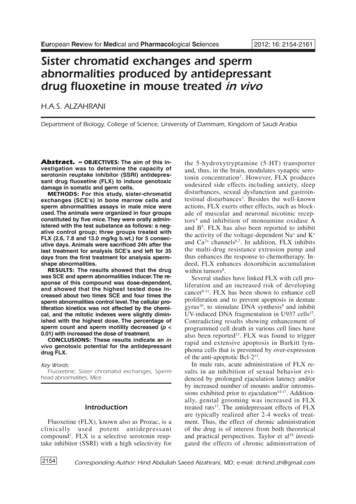
Transcription
European Review for Medical and Pharmacological Sciences2012; 16: 2154-2161Sister chromatid exchanges and spermabnormalities produced by antidepressantdrug fluoxetine in mouse treated in vivoH.A.S. ALZAHRANIDepartment of Biology, College of Science, University of Dammam, Kingdom of Saudi ArabiaAbstract. – OBJECTIVES: The aim of this investigation was to determine the capacity ofserotonin reuptake inhibitor (SSRI) antidepressant drug fluoxetine (FLX) to induce genotoxicdamage in somatic and germ cells.METHODS: For this study, sister-chromatidexchanges (SCE’s) in bone marrow cells andsperm abnormalities assays in male mice wereused. The animals were organized in four groupsconstituted by five mice. They were orally administered with the test substance as follows: a negative control group; three groups treated withFLX (2.6, 7.8 and 13.0 mg/kg b.wt.) for 5 consecutive days. Animals were sacrificed 24h after thelast treatment for analysis SCE’s and left for 35days from the first treatment for analysis spermshape abnormalities.RESULTS: The results showed that the drugwas SCE and sperm abnormalities inducer. The response of this compound was dose-dependent,and showed that the highest tested dose increased about two times SCE and four times thesperm abnormalities control level. The cellular proliferation kinetics was not affected by the chemical, and the mitotic indexes were slightly diminished with the highest dose. The percentage ofsperm count and sperm motility decreased (p 0.01) with increased the dose of treatment.CONCLUSIONS: These results indicate an invivo genotoxic potential for the antidepressantdrug FLX.Key Words:Fluoxetine, Sister chromatid exchanges, Spermhead abnormalities, Mice.IntroductionFluoxetine (FLX), known also as Prozac, is aclinically used potent antidepressantcompound1. FLX is a selective serotonin reuptake inhibitor (SSRI) with a high selectivity for2154the 5-hydroxytryptamine (5-HT) transporterand, thus, in the brain, modulates synaptic serotonin concentration2. However, FLX producesundesired side effects including anxiety, sleepdisturbances, sexual dysfunction and gastrointestinal disturbances3. Besides the well-knownactions, FLX exerts other effects, such as blockade of muscular and neuronal nicotinic receptors 4 and inhibition of monoamine oxidase Aand B5. FLX has also been reported to inhibitthe activity of the voltage-dependent Na and K and Ca2 channels6,7. In addition, FLX inhibitsthe multi-drug resistance extrusion pump andthus enhances the response to chemotherapy. Indeed, FLX enhances doxorubicin accumulationwithin tumors8.Several studies have linked FLX with cell proliferation and an increased risk of developingcancer9-11. FLX has been shown to enhance cellproliferation and to prevent apoptosis in dentategyrus10, to stimulate DNA synthesis9 and inhibitUV-induced DNA fragmentation in U937 cells12.Contradicting results showing enhancement ofprogrammed cell death in various cell lines havealso been reported13. FLX was found to triggerrapid and extensive apoptosis in Burkitt lymphoma cells that is prevented by over-expressionof the anti-apoptotic Bcl-213.In male rats, acute administration of FLX results in an inhibition of sexual behavior evidenced by prolonged ejaculation latency and/orby increased number of mounts and/or intromissions exhibited prior to ejaculation14-17. Additionally, genital grooming was increased in FLXtreated rats17. The antidepressant effects of FLXare typically realized after 2-4 weeks of treatment. Thus, the effect of chronic administrationof the drug is of interest from both theoreticaland practical perspectives. Taylor et al18 investigated the effects of chronic administration ofCorresponding Author: Hind Abdullah Saeed Alzahrani, MD; e-mail: dr.hind.zh@gmail.com
Sister chromatid exchanges and sperm abnormalities produced by antidepressant drug fluoxetineFLX (0.75 mg/kg; 28 days) on social behaviorand copulation. Vega Matuszcyk et al19 reportedthat subchronic administration of FLX (10mg/kg; 13 and 28 days) inhibited the copulatorypattern by increasing latency to ejaculation andincreasing the frequency of mounts. Further, theyreported that FLX reduced the apparent motivation of the male rat to pursue an estrous femalebased on the amount of time the male spent nearthe female rat.Although many clinical and basic researchstudies have examined the safety and efficacy ofSSRI’s in the adult population20,21, little researchexists regarding their use during development.Still, the United States Food and Drug Administration (USFDA) recently approved, FLX for usein children age 7-17 years old22, despite seriousreservations regarding the drug’s efficacy in children23,24. A subsequent report from the U.S. Department of Health and Human Services’ Panelon Developmental Toxicity of Fluoxetine determined that “Sufficient evidence exists for thePanel to conclude that FLX exhibits developmental toxicity ”25. Although a meta-analysis conducted by Whittington et al 26, who examinedboth published and unpublished clinical trials ofadolescent FLX use, reported that FLX seems tohave a favorable risk-benefit profile in adolescents. Consequently, based on this lack of adolescent FLX exposure studies, along with the adverse effects reported to occur with other SSRI’s27,28, caution needs to be heeded before theuse of SSRI treatments in the adolescent population is fully accepted.In spite of the extensive use of such medication there is no clear definition in regard to theirgenotoxic capacity; the literature shows heterogeneous data and almost a lack of in vivo studies.Therefore, the genotoxic evaluation of FLX using various in vivo endpoints was undertaken.Materials and MethodsAnimalsMale white Swiss mice aged 9-12 weeks wereused in all experiments. The animals were obtained from a closed random-bred colony at theCollege of Pharmacy, University of King Saud inRhiyad. The mice used for any one experimentwere selected from mice of similar age ( 1week) and weight ( 2 g). Animals were housedin polycarbonate boxes with steel-wire tops (notmore than five animals per cage) and beddedwith wood shavings. Ambient temperature wascontrolled at 22 3 C with a relative humidity of50 15% and a 12-h light/dark photoperiod. Foodand water were provided ad libitum. Animalswere sacrificed after treatment by cervical dislocation.ChemicalsFluoxetine was purchased from Sigma Chemical Co., St. Louis, MO, USA. All other chemicalsused were of analytical grade.DosesThe human therapeutic doses of the testeddrug was converted to mice therapeutic equivalent doses using the dose-conversion table ofPaget and Barnes29. Animals were divided into 4groups of 5 animals each. Group I were used asnegative control. Groups II, III and IV weretreated orally with 2.6, 7.8 and 13.0 mg FLX/kgb.wt. for 5 consecutive days, respectively. Animals were sacrificed 24h after the last treatmentsfor analysis SCE’s and left for 35 days from thefirst treatment for analysis sperm-shape abnormalities.Sister Chromatid Exchanges (SCE’s)The method described by Allen30, for conducting in vivo SCE’s induction analysis in mice wasapplied with some modifications. Approximately55 mg 5’-bromodeoxyuridine (BrdU, Fluka AG,Buchs SG, Riedstr, Steinheim, Switzerland)tablets were inserted in mice subcutaneously(s.c.) 21-23h before sacrifice. Mice were injectedintraperitonealy with colchicine at a final concentration of 3 mg/kg body wt. 2hrs before sacrifice. Bone-marrow cells from both femurs werecollected. The fluorescence-photolysis Giemsatechnique was used 31 (Litz light microscope,Wetzlar, Germany). The microscopic analysis permouse was carried out as follows: 40 second-division metaphases to determine the frequency ofSCE’s, 1000 cells to determine mitotic indexes(MI) which was equal to 1/(M1 2M2 3M3)100and 100 cells to establish the cellular proliferations kinetics (CPK). Based on the CPK values,we obtained the average generation time (AGT)which was equal to 24/ (M1 2M2 3M3)100.M1, M2 and M3 corresponded to the number ofcells in first, second and third cellular division,respectively.2155
H.A.S. AlzahraniEpididymal Sperm Count, Motility andAbnormal SpermThe mice were sacrificed by cervical dislocation. The epididymes were excised and placed ina prewarmed Petri dish containing 1 ml phosphate buffered saline (PBS, pH 7.4) at 37 C andplaced in a 37 C incubator for 15 min, prior todetermining sperm motility. The suspension wasstirred, one drop was placed on a warmed microscope slide, and a 22 22 mm cover slip wasadded. Microscopic fields were observed at 400 magnification using a standard light microscope, and the percentage of motile sperm wasdetermined. Five micro liters of the sperm suspension was transferred into an Eppendorf tubeand diluted with 95 µl of PBS. After mixing, thesperm suspensions were counted. Sperm countswere made using a Thoma counting chamber andexpressed as X106/ml. A drop of sperm suspension was smeared onto a slide and stained withEosin Y stain32. 1000 sperm per animal (5 animals/group) were assessed for morphological abnormalities of the sperm shape.Statistical AnalysisThe significance of the results from the controldata was calculated using Student’s t-test. A difference in the mean value of p 0.05 was considered to be statistically significant.ResultsSister Chromatid ExchangesThe frequency of SCE’s induced by FLX isshown in Table I. The low dose administered (2.6mg/kg b.wt) did not increase the number ofSCE’s with respect to the value of the negativecontrol group. However, the two high doses produced a genotoxic effect. With 13 mg/kg b.wt.the increase over the control level was 3.31SCE’s. The MI and the AGT produced by thecompound are also shown in Table I. With respect to the first parameter, the chemical produced a cytotoxic effect with only the highestdose tested, which inhibited the MI 28% with respect to the control mean. The CPK was characterized by the number of mitosis in M1, in M2,and in M3, which was very close to the rate observed in the control mice; these results produceda homogeneous AGT value in the experiment(between 12.41 and 12.44 h).Epididymal Sperm Count, Motility andAbnormal SpermAdministration of FLX with the three different doses once daily for 5 consecutive days significantly (p 0.01) reduced sperm count in alltested doses compared to the control group(Table II). Furthermore, the drug caused a significant decrease in the sperm motility. Themean value of Johnsen’s score in control groupwas 88.64 4.54; the treatment reduced significantly (p 0.01) the mean of the score to62.22 4.82 after treatment with the high testeddose of FLX. The mean percentage of spermshape abnormalities for animals treated withFLX was increased with dose response (TableII). The percentage of sperm abnormalities wasstatistically significant (p 0.01) with all thetested doses. The maximum percentage reached6.16 0.52 (p 0.01) compared to the controlgroup 1.32 0.40. Table II also represents thenumber and means percentage of sperm shapeabnormalities and the main types demonstratedwith head abnormalities.Table I. Frequency of sister chromatid exchanges (SCE’s) in mouse bone-marrow cells treated with FLX.Dose(mg/kgb. wt.)No. of different types ofSCEs/chromosomeSingleDoubleTripleTotal No.ofSCE’saI. Control433593560II. Cellbmean SE–MI X SE–AGT X SE2.80 0.355.30 0.3512.41 0.283.84 0.404.86 0.31*6.11 0.50**5.35 0.425.18 0.295.02 0.31*12.42 0.3412.44 0.2212.37 0.24aThe total number of chromosomes is 8000; bThe total number of scored cells is 200 (5 animals/group); *Significant p 0.05level; **Significant p 0.01 level (t-test).2156
Sperm count(x 106/ml)mean SE25.43 1.9014.14 4.92*10.10 5.52**8.54 5.36**Spermmotilitymean % SE88.64 4.5472.18 4.82*66.63 6.32**62.22 4.82**Sister chromatid exchanges and sperm abnormalities produced by antidepressant drug fluoxetineFigure 1. Fluoxetine.343851245Total No of sperm count 5000; *Significant p 0.05 level; **Significant p 0.01 level (t-test).38146580101214555455282170227308II. FLX2.67.813.03.40 0.46**4.54 0.28**6.16 0.52**82–20122466I. Control1.32 0.40SmallBananaTriangleWithout hookAmorphousNoMean % S.E.Number of sperm head abnormalitiesAbnormal spermDose(mg/kgb. wt.)Table II. Percentage of sperm abnormalities induced in male mice after oral treatment with different doses of FLX.CoiledtailDiscussionMedication in most cases may produce secondary health effects of variable degree, which insome cases may be a serious human health hazard. This potential damage is of particular concern with respect to compounds used for long periods and/or during pregnancy. The antidepressants studied are medicaments that may be continuously consumed for 6 months or longer, witha possible repetition of the treatment 33. Also,there have been reports showing collateral healtheffects, mainly on the cardiovascular system34,35,although other types of alterations have been described as well: for example, myoclonus, sexualdysfunction, and hyponatremia36-38. Besides, thedevelopment of mammary cancer and pheochromocytoma has been described39,40, as well as afew cases of neonatal adaptation impairment andwithdrawal syndrome when administered in thethird trimester of pregnancy41,42. On the otherhand, it is known that therapeutic drugs may produce genotoxic damage by a direct interactionwith DNA or after their metabolic transformation, and that by establishing their genotoxic level it is possible to propose preventive measures43.There is an almost lack of in vivo mammalianstudies to evaluate the effect of FLX on the genetic material. Our findings confirm the usefulness of the SCE evaluation to detect genotoxicity; it show a dose-dependent effect produced byFigure 2. Metaphases from mice treated with FLX showingsister chromatid exchanges from mouse bone marrow cells.2157
H.A.S. AlzahraniABCDFigure 3. Sperm shape abnormalities induced in male mice treated with FLX showing (A) normal, (B) amorphous, (C) triangular and (D) coiled tail.FLX, and a clear SCE increase with the medianand highest doses treatment for five consecutivedays. The results agree with Saxena and Ahuja44who observed that desipramine an antidepressantdrug increases the frequency of SCE’s and chromosomal aberrations in human lymphocyte cultures. Paniagua-Perez et al 45 reported thatimipramine and desipramine have the ability toinduced SCE’s in mice bone marrow cells invivo. Also, desipramine induced the genotoxicdamage using the wing somatic and recombination test in Drosophila46. Kusakawa et al47 revealed that FLX exhibits strong embryonic toxicity by assessment with IC50 and ID50 values, using a mouse ES cell differentiation system.Sperms are important target cells in reproductive toxicology for assessment of spermatogenicdamage, fertility and heritable genetic mutations 48,49. Although not widely used in mutagenicity testing, the sperm morphology testproves to be a sensitive one. Sperm tests have also been used to study chemically induced spermmutagenic dysfunction in other mammalianspecies, including humans49.There are few data concerning the effects ofantidepressant drug on the reproductive systemof male mice. The results of the present study indicated that FLX administration at the doses of2.6, 7.8 and 13 mg/kg b.wt resulted in a significant decrease in both sperm motility and count (p 0.01) of the mice. Moreover, it induced increase in abnormal spermatozoa (p 0.01).The present results indicate that the administration of FLX causes a strong toxic effect onmouse seminiferous epithelium. The significantincrease in sperm shape abnormalities may reflect chromosome abnormalities in primary spermatocytes and spermatids, and has always been2158associated with infertility32,50. Sperm-shaping ispolygenetically controlled by numerous autosomal and sex-linked genes51; while sperm head abnormality was found to be correlated to germ cellmutational activity51. Induced sperm abnormalities indicate point mutations in germ cells 52,which should have triggered structural changes incell organelles involved in head and tail formation, leading to sperm abnormalities.Sexual dysfunction in both men and women hasbeen reported frequently, but it is not always possible to differentiate drug-induced adverse effectsfrom those induced by the underlying disease.Studies in men have suggested that SSRIs maydamage normal sperm DNA integrity and therebyadversely affect fertility53,54. Safarinejad53 reportedthat patients receiving SSRIs have sperm countand sperm motility (p 0.01) lower than the normal control. Furthermore, SSRIs induced spermabnormality (p 0.01) higher compared to the normal patients. In men with normal semen parameters, paroxetine induced abnormal sperm DNAfragmentation in a significant proportion of subjects. The fertility potential of a substantial number of men on paroxetine may be adversely affected by these changes in sperm DNA integrity54. Also, lower serum gonadotropin and testosteronelevels have been reported in depressed men treatedwith SSRIs compared to healthy men55. However,it is not known if these changes are related to depression or the medication.Lister et al 56 reported that exposure of zebrafish (Danio rerio) to FLX for 7 d at environmentally relevant concentrations (0.32-32 µg L-1)can significantly decrease egg production. Japanese medaka (Oryzias latipes) exposed to FLX atconcentrations as low as 0.1 µg L-1 for 4 weeksshowed significantly elevated plasma estradiol
Sister chromatid exchanges and sperm abnormalities produced by antidepressant drug fluoxetineand developmental deformities amongoffspring57. In goldfish (Carassius auratus), FLX(five injections of 5 µg g-1over 14 d) decreasedtranscript levels in the brain of isotocin, the fishhomolog of the mammalian neuropeptide oxytocin, indicating a mechanistic link between FLXexposure and reproductive dysfunction58.Reduced sperm concentration in the presentstudy can be explained by a toxic effect of thedoses of antidepressant on spermatozoa as wellas spermatogonia and additionally a secondaryeffect related with negative feedback on steroidhormone negative feedback via the testes on thehypothalamus59. Friedman et al59, moreover, reported that a higher cycle cancellation rate wasobserved secondary to poor ovarian response inwomen using SSRIs compared to nonusers. TheAuthors speculated that SSRI drugs may interfere with the hypothalamic-gonadal axis in subtle ways.The chemical structure of the antidepressantsincludes two potentially dangerous componentsrelated with mutagenic and carcinogenic events,and particularly with the formation of SCE’s: oneof these components is the aromatic ring, and theother the nitro group60,61. The latter may be transformed into nitroso compounds causes genotoxicdamage62. So much more care should be takenwhen we used antidepressant drugs.References1) WONG DT, BYMASTER FP, ENGLEMAN EA. Prozac (fluoxetine, Lilly 110140), the first selective serotoninuptake inhibitor and an antidepressant drug:twenty years since its first publication. Life Sci1995; 57: 411-441.2) FULLER RW, WONG DT, ROBERTSON DW. Fluoxetine, aselective inhibitor of serotonin uptake. Med ResRev 1991; 11: 17-34.3) BRAMBILLA G, MATTIOLI F, MARTELLI A. Genotoxic andcarcinogenic effects of antipsychotics and antidepressants. Toxicology 2009; 261: 77-88.4) GARCIA-COLUNGA J, AWAD JN, MILEDI R. Blockage ofmuscle and neuronal nicotinic acetylcholine receptors by fluoxetine (Prozac). Proc Natl Acad SciUSA 1997; 94: 2041-2044.5) LEONARDI ET, AZMITIA EC. MDMA (ecstasy) inhibitionof MAO type A and type B: comparisons with fenfluramine and fluoxetine (Prozac). Neuropsychopharmacology 1994; 10: 231-238.6) PANCRAZIO JJ, KAMATCHI GL, ROSCOE AK, LYNCH C. Inhibition of neuronal Na channels by antidepressant drugs. J Pharmacol Exp Ther 1998; 284:208-214.7) DEAK F, LASZTOCZI B, PACHER P, PETHEO GL, VALERIAK, S PAT A. Inhibition of voltage-gated calciumchannels by fluoxetine in rat hippocampal pyramidal cells. Neurophar macology 2000; 39:1029-1036.8) PEER D, DEKEL Y, MELIKHOV D, MARGALIT R. Fluoxetineinhibits multidrug resistance extrusion pumps andenhances responses to chemotherapy in syngeneic and in human xenograft mouse tumormodels. Cancer Res 2004; 64: 7562-7569.9) B RANDES LJ, A RRON RJ, B OGDANOVIC RP, T ONG J,Z ABORNIAK CL, H OGG GR, WARRINGTON RC, FANGW, LABELLA FS. Stimulation of malignant growthin rodents by antidepressant drugs at clinicallyrelevant doses. Cancer Res 1992; 52: 37963800.10) LEE HJ, KIM JW, YIM SV, KIM MJ, KIM SA, KIM YJ, KIMCJ, CHUNG JH. Fluoxetine enhances cell proliferation and prevents apoptosis in dentate gyrus ofmaternally separated rats. Mol Psychiatry 2001;6: 725-728.11) MANEV R, UZ T, MANEV H. Fluoxetine increases thecontent of neurotrophic protein S100beta in therat hippocampus. Eur J Pharmacol 2001; 420: R1R2.12) WRIGHT SC, ZHONG J, LARRICK JW. Inhibition of apoptosis as a mechanism of tumor promotion. FASEBJ 1994; 8: 654-660.13) S ERAFEIM A, H OLDER MJ, G RAFTON G, C HAMBA A,DRAYSON MT, LUONG QT, BUNCE CM, GREGORY CD,BARNES NM, GORDON J. Selective serotonin reuptake inhibitors directly signal for apoptosis in biopsy-like Burkitt lymphoma cells. Blood 2003; 101:3212-3219.14) BAUM MJ, STARR MS. Inhibition of sexual behaviorby dopamine antagonist or serotonin agonistdrugs in castrated male rats given estradiol or dihydrotestosterone. Pharmacol Biochem Behav1980; 13: 57-67.15) YELLS DP, PRENDERGAST MA, HENDRICKS SE. Lesions ofthe nucleus paragigantocellularis: effects on mating behavior in male rats. Brain Res 1992; 596:73-79.16) YELLS DP, PRENDERGAST MA, HENDRICKS SE, NAKAMURAM. Fluoxetine-induced inhibition of male rat copulatory behavior: Modification by lesions of the nucleus paragigantocellularis. Pharmacol BiochemBehav 1994; 49: 121-127.17) YELLS DP, PRENDERGAST MA, HENDRICKS SE, MILLER ME.Monoaminergic influences on temporal patterningof sexual behavior in male rats. Physiol Behav1995; 58: 847-852.18) T AYLOR G, B ARDGETT M, C SERNANSKY J, E ARLY T,HALLER J, SCHERRER J, WOMACK S. Male reproductive systems under chronic fluoxetine or trimipramine treatment. Physiol Behav 1996; 59:479-485.19) VEGA MATUSZCYK J, LARSSON K, ERIKSSON E. The selective serotonin reuptake inhibitor fluoxetine reduces sexual motivation in male rats. PharmacolBiochem Behav 1998; 60: 527-532.2159
H.A.S. Alzahrani20) WILLIAMS JW, MULROW CD, CHIQUETTE E, NOEL PH,AGUILAR C, CORNELL J. A systematic review of newer pharmacotherapies for depression in adults.Ann Intern Med 2000; 132: 743-75621) DEVANE CL. Comparative safety and tolerability ofselective serotonin reuptake inhibitors. Hum Psychopharmacol Clin Exp 2004; 10: 185-193.22) UNITED STATES FOOD AND DRUG ADMINISTRATION. FDAapproves Prozac for pediatric use to treat depression and OCD. FDA Talk Paper 2003; ANS01187.html.23) GARLAND EJ. Facing the evidence: antidepressanttreatment in children and adolescents. Can MedAssoc J 2004; 170: 489-491.24) JUREIDINI JN, DOEKE CJ, MANSFIELD PR, HABY MM,MENKES DB, TONKIN AL. Efficacy and safety of antidepressants for children and adolescents. Br MedJ 2004; 328: 879-883.25) NTP-CERHR, NATIONAL TOXICOLOGY PROGRAM. Centerfor the evaluation of risks to human reproductionexpert panel report on the reproductive and developmental toxicity of fluoxetine 2004.http://cerhr.niehs.nih.gov.26) WHITTINGTON CJ, KENDALL T, FONAGY P, COTTRELL D,COTGROVE D, BODDINGTON E. Selective serotoninreuptake inhibitors in childhood depression: systematic review of published versus unpublisheddata. Lancet 2004; 363: 1341-1345.27) C OMMITTEE ON S AFETY OF M EDICINES . Selectives e r o t o n i n r e u p t a ke i n h i b i t o r s ( S S R I s ) :Overview of regulatory status and CSM advicerelating to major depressive disorder (MDD) inchildren and adolescents including a summaryof available safety and efficacy data. tm.28) UNITED STATES FOOD AND DRUG ADMINISTRATION. FDAissues public health advisory on cautions for useof antidepressants in adults and children. FDATalk Paper S01283.html.29) PAGET GE, BARNES JM. Evaluation of drug activities.In: Laurence DR, Bacharach AL(Eds.), Pharmacometrics 1964; Vol I London Academic Press,pp. 50.30) ALLEN JW. A method for conducting in vivo SCEinduction analysis in mice. Genetic ToxicologyDivision US Environ Protection Agency Research Triangle Park North Carolina 27711,1982.31) PERRY P, WOLFF S. New Giemsa method for the differential staining of sister chromatids. Nature(London) 1974; 251: 156-158.32) Wyrobek AJ, Bruce WR. The induction of spermshape abnormalities in mice and humans, In: Hallaender A, De Serres FJ (eds.) Chemical Mutagens: Principles and methods for their detection.Plenum, New York, 1978; Vol. 5: pp. 257-285.216033) FROMMER DA, KULIG KW, MARX JA, RUMACK B. Tricyclic antidepressant overdose. J Am Med Assoc1987; 257: 521-526.34) FASOLI RA, GLAUSER FL, BECH P. Imipramine clinicaleffects and pharmacokinetic: cardiac arrhytmıasand ECG abnormalities in tricyclic antidepressantoverdose. Clin Toxicol 1981; 18: 155-163.35) BURROWS GA, VOHRA J. Cardiac effects of differenttricyclic antidepressants. Br J Psychiatr 1986;129: 335-341.36) COLGATE R. Hyponatremia and inappropiate secretion of antidiuretic hormone associated with theuse of imipramine. Br J Psychiatry 1993; 163:819-822.37) KARP JF. Imipramine and sexual dysfunction during the long-term treatment of recurrent depression. Neuropsychopharmacology 1994; 11: 2127.38) BLACK KJ, KILZICH N. Severe imipramine inducedmyoclonus in a patient with psychotic bipolar depression, catatonia and schizencephaly. Ann ClinPsychiatry 1994; 6: 45-49.39) NEMECEK S, BACKFIRE. Could prozac and elavial promote tumor growth? Sci Am 1994; 27: 22-23.40) FERGUSON KL. Imipramine provoked paradoxicalpheochromocytoma crisis. Am J 1994; 2: 190192.41) WEBSTER PA. Withdrawal symptoms in neonatesassociated with maternal antidepressant therapy.Lancet 1973; 3: 318-319.42) BARES M. The use of antidepressants during pregnancy and lactation. Psychiatry 2000; 3: 1-16.43) FARBER E. Possible Etiologic mechanism in chemical carcinogenesis. Environ Health Perspect1987; 75: 65-70.44) SAXENA R, AHUJA YR. Genotoxicity evatuation of thetricyclic antidepressants amitriptyline andimipramine using human lymphocyte cultures. Environ Mol Mutagen1988; 12: 421-430.45) PANIAGUA-PÉREZ R, MADRIGAL-BUJAIDAR E, REYES CS,PÉREZ GJ, VELASCO MO, MOLINA D. Sister chromatidexchanges produced by imipramine and desipramine in mouse bone marrow cells treated invivo. Toxicol Lett 2002; 132: 123-129.46) VAN SCHAIK N, GRAF U. Genotoxicity evaluation offive tricyclic antidepressants in the wing somaticmutation and recombination testing Drosophilamelanogaster. Mutat Res 1991; 260: 99-104.47) K USAKAWA S, YAMAUCHI J, M IYAMOTO Y, S ANBE A,TANOUE A. Estimation of embryotoxic effect of fluoxetine using embryonic stem cell differentiationsystem. Life Sci 2008; 83: 871-877.48) KRZANOWSKA H. Inheritance of sperm head abnormality types in mice and the role of the Y chromosome. Genet Res 1976; 28: 189-198.49) A DLER ID. Stage-sensitivity and dose-responsestudy after cirradiation of mouse spermatocytes.Int J Rad Biol 1977; 31: 79-85.50) W YROBEK AJ, WAVCHMAKER G, G ORDON L. Spermmorphology testing in mice. In: Kilbey BJ, Nichol
Sister chromatid exchanges and sperm abnormalities produced by antidepressant drug fluoxetineM, Ramel C. (Eds.), Handbook of MutagenicityTest Procedures, second ed. Elsevier ScienceAmsterdam1984; pp. 739-750.51) OTUBANJO AO, MOSOURO AA. An in vivo evaluationof induction of abnormal sperm morphology bysome anthelmentic drugs in mice. Mutation Res2001; 497: 131-138.52) ACHARYA UR, MISHRA I, RASHMI M, TRIPATHY R. Potential role of vitamins in chromium induced spermatogenesis in Swiss mice. Environ Toxicol Pharmacol 2004; 15:3-59.53) SAFARINEJAD MR. Sperm DNA damage and semenquality impairment after treatment with selectiveserotonin reuptake inhibitors detected using semen analysis and sperm chromatin structure assay. J Urol 2008a; 180: 2124-2128.54) TANRIKUT C, FELDMAN AS, ALTEMUS M, PADUCH DA,S CHLEGEL PN. Adverse effect of paroxetine onsperm. Fertil Steril 2010; 94: 1021-1026.55) SAFARINEJAD MR. Evaluation of endocrine profileand hypothalamic-pituitary testis axis in selectiveserotonin reuptake inhibitor-induced male sexualdysfunction. J Clin Psychopharmacol 2008; 28:418-23.56) LISTER A, REGAN C, VAN ZWOL J, VAN DER KRAAK G.Inhibition of egg production in zebrafish by fluoxetine and municipal effluents: a mechanistic evaluation. Aquat Toxicol 2009; 95: 320-329.57) F ORAN CM, W ESTON J, S LATTERY M, B ROOKS BW,HUGGETT DB. Reproductive assessment of Japanese medaka (Oryzias latipes) following a fourweek fluoxetine (SSRI) exposure. Arch EnvironContam Toxicol 2004; 46: 511-517.58) MENNIGEN JA, MARTYNIUK CJ, CRUMP K, X IONG H,ZHAO E, POPESKU J, ANISMAN H, COSSINS AR, XIA X,TRUDEAU VL. Effects of fluoxetine on the reproductive axis of female goldfish (Carassius auratus).Physiol Genom 2008; 35: 273-282.59) FRIEDMAN BE, ROGERS JL, SHAHINE LK, WESTPHAL LM,LATHI RB. Effect of selective serotonin reuptake inhibitors on in vitro fertilization outcome. FertilSteril 2009; 92: 1312-1314.60) BRADLEY MO, BHUYAN B, FRANCIS MC, LANGENBACH R,PETERSON A, HUBERMAN E. Mutagenesis by chemicalagents in V79 Chinese hamster cells: a reviewand analysis of the literature. A report of theGene-Tox Program. Mutat Res 1981; 87: 81-142.61) WEINSTEIN IB. The origins of human cancer: molecular mechanisms of carcinogenesis and their implications for cancer prevention and treatment–twenty-seventh G.H.A. Cloves memorial awardlectures. Cancer Res 1988; 48: 4135-4143.62) BRAMBILLA P, CIPRIANI A, HOTOPF M, BARBUI C. Side-effect profile of
cal Co., St. Louis, MO, USA. All other chemicals used were of analytical grade. Doses The human therapeutic doses of the tested drug was converted to mice therapeutic equiva-lent doses using the dose-conversion table of Paget and Barnes29. Animals were divided into 4 groups of 5 animals each. Group I were used as negative control. Groups II .
